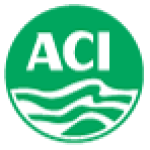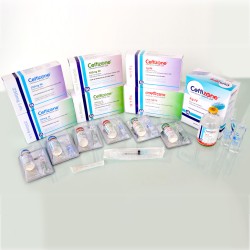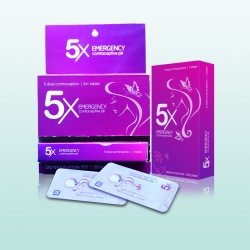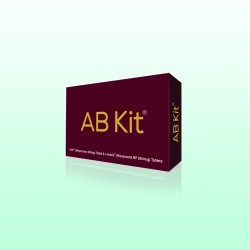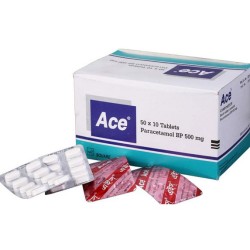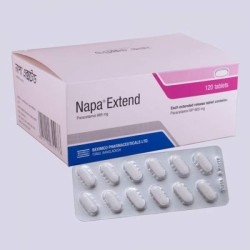Arixon 500mg/vial IV Injection 1's Pack

Arixon 500mg/vial IV Injection 1's Pack
৳ 130.00/=
Ex Tax: ৳ 130.00/=
- Stock: In Stock
- Model: Medi-00656
- Generic: Ceftriaxone IV
- Pack Size: Each Box contains Arixon 500mg/vial IV Injection 1's Pack
0 items sold
4030 views
Available Options
Indications
Ceftriaxone is indicated for the treatment of sepsis, meningitis, abdominal infections (peritonitis, infections of the biliary and gastro intestinal tracts), infections of the bones, joints, soft tissue, skin and/or wounds infections in patients with impaired defense mechanism, renal and urinary tract infections, respiratory tract infections, particularly pneumonia, and ear, nose and throat infections, genital infections including gonorrhoea.
Therapeutic Class
Third generation Cephalosporins
Pharmacology
Ceftriaxone is a third generation broad spectrum parenteral cephalosporin antibiotic. Ceftriaxone binds to 1 or more of the penicillin binding proteins (PBPs) which inhibit the final transpeptidation step of peptidoglycan synthesis in bacterial cell wall, thus inhibiting biosynthesis and arresting cell wall assembly resulting in bacterial cell death.
Dosage & Administration
Ceftriaxone can be administered either intravenously or intramuscularly. When reconstituted for intramuscular or intravenous injection, the white to yellowish-orange crystalline powder gives a pale yellow to amber solution.
Adults: The usual adult daily dose is 1-2 g once daily, (or twice daily in equally divided doses) depending on the type and severity of infection. The daily dose may be increased, but should not exceed 4 g. For preoperative use (surgical prophylaxis), a single dose of 1 gm administered intravenously 0.5-2 hours before surgery is recommended.
In elderly patients:
Adults: The usual adult daily dose is 1-2 g once daily, (or twice daily in equally divided doses) depending on the type and severity of infection. The daily dose may be increased, but should not exceed 4 g. For preoperative use (surgical prophylaxis), a single dose of 1 gm administered intravenously 0.5-2 hours before surgery is recommended.
In elderly patients:
- Usual dose: The dosages do not require modification provided that renal and hepatic functions are satisfactory. In patients with impaired renal function, there is no need to reduce the dosage of Ceftriaxone provided liver function is intact. In patients with liver damage, there is no need for the dosage to be reduced provided renal function is intact.
- Gonorrhea: For the treatment of gonorrhea (penicillinase producing and non-penicillinase producing strains), a single intramuscular dose of 250 mg is recommended.
- Usual dose: The recommended total daily dose is 50 to 75 mg/kg once daily (or twice daily in equally divided doses).
- In severe infections, up to 80 mg/kg body weight daily may be given. The total daily dose should not exceed 2 gm.
- In the treatment of meningitis, the initial dose of 100 mg/kg body weight (not to exceed 4 gm daily) once daily (or twice daily in equally divided doses), is recommended. As soon as the causative organism has been identified and its sensitivity, the doses can be reduced accordingly. The usual duration of therapy in meningitis is 7 to 14 days.
Interaction
May increase nephrotoxicity of aminoglycosides. May diminish therapeutic effect of BCG, typhoid vaccine, Na picosulfate. May increase anticoagulant effect of vit K antagonists (e.g. warfarin). May increase serum level with probenecid.
Contraindications
Ceftriaxone should not be given to patients with a history of hypersensitivity to cephalosporin antibiotics. It is contraindicated in premature infants during the first 6 weeks of life. Its safety in human pregnancy has not been established. Ceftriaxone is contraindicated in neonates if they require (or are expected to require) treatment with calcium-containing IV solutions, including continuous calcium containing infusions such as parenteral nutrition because of the risk of precipitation of ceftriaxone-calcium.
Side Effects
Ceftriaxone is generally well tolerated. A few side-effects such as
- Gastrointestinal effects include diarrhea, nausea and vomiting, stomatitis and glossitis
- Cutaneous reactions include rash, pruritus, urticaria, edema & erythema multiforme
- Hematological reactions include eosinophilia, thrombocytosis, leukopenia, and neutropenia
- Hepatic reactions include elevations of SGOT or SGPT, bilirubinemia
- CNS reactions include headache, hyperactivity, nervousness, sleep disturbances, confusion, hypertonia, and dizziness were reported. Local phlebitis occurs rarely following intravenous administration but can be minimized by slow injections over 2-4 minutes.
Pregnancy & Lactation
pregnancy category B. Ceftriaxone has not been associated with adverse effects on fetal development in laboratory animals, but its safety in human pregnancy has not been established. Therefore, it should not be used in pregnancy unless absolutely indicated. Because ceftriaxone is distributed into milk, the drug should be used with caution in nursing women.
Precautions
Patient with history of penicillin allergy, history of GI disease esp colitis, gallbladder disease. Renal or hepatic impairment. Pregnancy and lactation. As with other Cephalosporins anaphylactic shock cannot be rubbed out even if a thorough patient history is taken. Anaphylactic shock requires immediate counter measures.
Overdose Effects
Symptoms: Nausea, vomiting, diarrhoea.
Management: Symptomatic and supportive treatment.
Management: Symptomatic and supportive treatment.
Storage Conditions
Store below 25°C, protected from light & moisture. Use reconstituted solutions immediately.
Reconstituted solutions are stable for 6 hours at room temperature and for 24 hours at 2°-8°C. It should not be mixed in the same syringe with any drug other than 1% Lidocaine Hydrochloride injection BP (for IM injection only).
Reconstituted solutions are stable for 6 hours at room temperature and for 24 hours at 2°-8°C. It should not be mixed in the same syringe with any drug other than 1% Lidocaine Hydrochloride injection BP (for IM injection only).
Source: medex.com.bd



